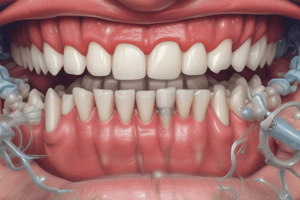Podcast
Questions and Answers
Flashcards
What is an index?
What is an index?
Expression of clinical observation in numeric values.
Purpose of an index
Purpose of an index
To increase understanding of disease process, leading to better control and prevention methods; to identify populations at high and low risk.
Criteria for index selection
Criteria for index selection
Should be simple to use and calculate, permit examination of many people in a short period, have clear criteria, be free from subjective interpretation, define clinical conditions objectively, be reproducible, amenable to statistical analysis, relate numerically to clinical stage, be sensitive, and not cause discomfort.
Classification of indices
Classification of indices
Signup and view all the flashcards
What is a reversible index?
What is a reversible index?
Signup and view all the flashcards
What is an irreversible index?
What is an irreversible index?
Signup and view all the flashcards
Study Notes
Benefits of Epidemiology
- Epidemiology helps in identification of etiological factors
- Epidemiology assists in the planning of oral health services
- It supports curriculum planning
- It aids in estimating manpower
- It assists the evaluation of preventive programs
Index
- An index expresses clinical observations in numeric values
Purpose of Index
- The main purpose of an index in dental epidemiology is to increase understanding of disease processes
- The index helps discover populations at high and low risk
- Indexes can lead to methods of control and prevention
Criteria for Selection of Index
- Indexes have a simple use and calculation
- Indexes permit examination of many people in a short period
- They have criteria which defines its components clearly and readily
- Indexes are free from subjective interpretation
- They define clinical condition objectively
- Indexes are highly reproducible when used by one or more examiners
- They are amenable to statistical analysis
- Indexes strongly relate numerically to clinical stage of specific disease under investigation
- They are equally sensitive throughout the scale
- They do not cause discomfort to the patient
Classification of Indices
- Based on direction, indices can be irreversible or reversible
- Based on the disease, indices can be diseased, symptom, or treatment indexes
Types of Indices
- There are three types of indices
- Reversible indices are for gingivitis
- Irreversible indices are for destructive conditions like periodontitis
- Combined type indices are both reversible and irreversible
Studying That Suits You
Use AI to generate personalized quizzes and flashcards to suit your learning preferences.




